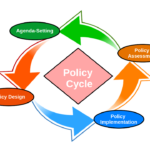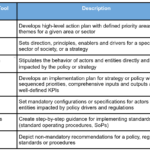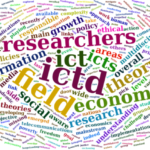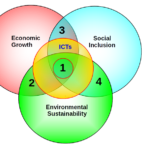Below are the inputs we provided DGG for the upcoming global governance consultations in Joburg in less than 2 weeks. The final text builds on inputs from Minerva and Ruhiya. This should be a live document which we should be updating on a regular basis.
Cheers, Raúl
ICTs for Democratic Governance
and Sustainable Development
The potential of information and communication technologies (ICTs) to support development efforts was already recognized when the Millennium Development Goals (MDGs) were agreed in 2000. Today, as we are working towards a post2015 development agenda, the role of ICTs as development enablers is more widely understood in their potential for opening new opportunities to foster democratic governance and achieve long-term sustainable human development.
The following are a few selected core messages to consider when we speak about ICTs in governance and human development:
Improving governance: ICTs can open up new channels for dialogue and consultation. Governments can harness this potential to reach marginalized populations, and establish governance mechanisms that ensure inclusive sustainable development. Mobile devices in particular, now in the hands of over six billion people -most of them in developing countries, present enormous potential to widen the political space for public engagement.
Fostering inclusive participation: Marginalized communities often have few opportunities and no leverage to influence public policy and decision-making processes that affect their lives. Yet as witnessed during the Arab Spring, ICTs are transforming political processes, empowering people to connect and mobilize, and enabling broader collective action. ICTs can enable those who have traditionally had little chance of engaging with these processes to finally have a voice and a meaningful role. ICTs can help stakeholders to better represent their priorities and critical needs, and at the same time assist governments and development partners to more effectively respond.
Broadening access to information: Now more than ever, greater numbers of people are able to access public information relevant to their welfare (budgets, laws and policies) via new ICTs, and are more able to demand transparency and hold their governments accountable. ICTs have substantially reduced the cost of production, reproduction and distribution of public information and data. In addition, it has provided new communication channels to stakeholders who can now disseminate their own information on a global scale. Social innovators can in turn become infomediaries and cater public information and data to the needs of local communities.
Improving service delivery: Innovative ICT solutions can enhance and diversify basic service delivery in health care, agriculture, livelihoods and education among others. By opening new and affordable information and communication channels with stakeholders, ICTs can also help inform and guide decisions on where public investments can have a bigger bang for the buck. This ensures that “supply meets demand” and that efforts are indeed targeted towards the most critical gaps.
Tackling crisis response and conflict prevention: New ICTs, particularly mobiles, allow for the rapid sharing of information for early warning and early response, as well as for more precise monitoring of conflicts and crisis. As emergency response tools, mobile technologies have helped establish networks of communication and crisis mapping systems, using crowd-sourcing tools and solutions that allowing people to track violence, crime, corruption and abuse among others.
Empowering women: ICT innovations enable health care delivery through remote consultations, entrepreneurship through access to pricing information, extension services and mobile banking, education and learning through on line resources, and participation in decision-making processes through better public information and access to public processes. Yet along with traditional gender-based constraints imposed by society, women are often excluded from receiving the benefits that new ICTs provide. They are 21% less likely to own a mobile phone, for instance, than men, according to the latest GSMA report, and many lag behind in the skills needed for employment and navigating modern services, further widening the information, knowledge, and opportunity divide. ICTs are thus not neutral and demand that complementary policies that explicitly address gender inequalities are in place.
Reaching youth: Half of the world’s population is now 24 years old or younger, and those between the ages of 10 and 24 years old currently constitute one-fifth of the world’s population. The vast majority of youth live in developing countries, comprising over half the total population in some countries (UNDESA 2010; UNFPA 2011). Mobile technology and social networking platforms are widely used by this emerging young demographic, and the potential of new ICTs in the hands youth for advancing development and democratic governance is immense. The youth are the natural champions of long-term sustainable development policies and programmes. Participation of young people in these processes is thus crucial.
Expanding social innovation: Social innovators and social entrepreneurs in developing countries are deploying innovative solutions for mobile phones that cater to local needs and challenges – improving health-care delivery through remote consultations, agricultural development through access to pricing information and extension services, and banking services through mobile banking in remote locations among other things. These innovations are diffusing throughout the world. Platforms such as Ushahidi and M-Pesa for example have become truly global successes and are being used and replicated in many countries. New jobs and livelihoods are being created. However, not all new solutions are scalable nor can they be easily replicated in other contexts. It is here where policy development and multi-stakeholder partnerships are essential. Governments can focus on linking social and development policies to social innovations, and help forge partnerships with the private sector and CSOs to make sure the new solutions can be mainstreamed.
Open government (OG): Participation, accountability and transparency (PAT) are the cornerstones of open government initiatives, such as the Open Government Partnership (OGP). While in the past PAT initiatives were basically reactive and supply-driven, new ICTs have turned around the table and placed the onus on stakeholders who are proactive and demand PAT at all levels. One component of OG is open data which directly relates to access to public information and empower people by providing real time data access to ongoing public and private initiatives and programmes. Social innovation is also fostering open data a data applications which present complex data in simple formats are now in the hands of stakeholders who can then meaningfully participate in public deliberations
ICTs: more than a tool. The old -fashioned view on technology in general and ICTs in particular reduces them to a tool that has, if anything, the benefit of increasing the efficiency of most processes and services in public administrations. While this might be the case in some circumstances, the real potential of new ICTs in the 21st century is to transform the way we do business, interact with each other and with public institutions, and engage in political affairs -as shown by the Arab Spring and other social movements on this century. Young people will continuously remind us of the transformational power of ICTs and their importance for long-term sustainable development.
ICTs and Climate Change. While ICTs are said to generate about 2% of carbon emissions, they are also part of the solution. ICT solutions not only provide the platforms to monitor climate change but also the required infostructure to generate and maintain the complex models that scientists use manage climate change and adaption. New ICT solutions such as could computing, smart cities and smart grids and meters provide the basis for green urban planning, green public administrations, improved water management systems, green supply chains and effective e-waste management.





